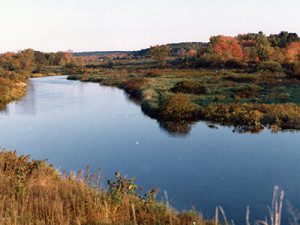[ccfic caption-text format="plaintext"]
The first settlers of Medfield came to the New World starting in 1630, in what became known as the Great Migration. During a twelve-year period, some 21,000 emigrants made their way from England to the Massachusetts Bay Colony.
These first settlers were Puritans who left England primarily due to religious persecution, but also for economic reasons. The Puritans were a sect of religious dissidents who felt the Church of England was too closely associated with the Catholic religion and needed to be reformed. They were not as radical as the Pilgrims or Separatists, who completely broke from the church. The Puritans wanted to stay within the church, but they wanted to reform it. Here, they could get away and make their reforms in the New World, far from the oversight of the Church of England, now an ocean away.
Medfield’s roots sprung from Dedham. The founding of Dedham came as a result of people moving there from earlier settled towns and villages, including Watertown. Here was a grant of land for some 200 square miles of American wilderness, at first known appropriately as Contentment. That original Dedham grant included not only the current town of Dedham, but also the future towns of Medfield, Wrentham, Needham, Natick, Franklin, Bellingham, Wellesley, Walpole, Westwood, Norfolk, Norwood and Dover
Dedham was incorporated in 1636. By 1640, Dedham men started harvesting the grasslands that grew in the meadows along the Charles River. These grasses became important for the feeding of the cattle and livestock back on the Dedham farms. Our area was first known as Dedham Village.
In November of 1649, Dedham held a town meeting which approved the laying out of an area for a new town. This was accomplished in the early spring of 1650, and corresponds very nearly with the boundaries of the present town. Also included in the layout of the new Town of Medfield was a grant by the General Court of land west of the Charles River, now Medway and Millis. Both the Dedham grant and the General Court grant were included in the new Town of Medfield. Medfield was first to break away from the original Dedham Grant. Medfield’s thirteen original settlers paid fifty pounds to the inhabitants of Dedham in compensation for the land.
Those first settlers included the families of Ralph Wheelock, John Ellis, Samuel Bullen, Daniel Morse, James Allen, Joseph Clark, Francis Hamant, John Turner, John Frairy, Timothy Dwight, Robert Hinsdale, Thomas Wight and John Wight.
The main road from Dedham to Medfield ran through the vicinity of what is today Clapboardtree Street in Westwood through the northeast corner of what is now Walpole, cutting through roughly where Bubbling Brook Ice Cream is located and entering Medfield along Foundry Street.
What were the homes of those first settlers like? Those first houses were log houses ― good, stout logs, straightened a little with the settler’s axe. The logs were laid one above the other to form the walls and locked together at the corners. The wind would not shake these houses much, though it may find some crevices. The cracks between the logs, however, would have been filled by wooden wedges and clay from the town clay pits by Bridge Street. Those first settlers never made an attempt to finish the house, either inside or outside - all was very rustic.
A look inside one of the houses would show two rooms - one large living room, which was a kitchen, sitting-room and work room all in one. The other room on that first floor was a sleeping room. The house was of one story, but with a loft, reached by a ladder, under the thatched roof, where the children would sleep. There were two windows of English diamond glass but in the loft and sleeping room, the windows were simply openings fitted with oiled paper panes, which let in a little subdued daylight. In the middle of the house was a wide heavy door, through which a horse would drag a big back-log for the fire.

The Charles River in Medfield, here grew the valuable grasslands needed for the farmer's livestock. Photos courtesy of Medfield Historical Society
At one end of the big room was a large fireplace, some ten feet wide, built of stone laid in clay, with a broad chimney of the same material rising above the loft and the thatched roof. The thatched roof was at the mercy of sparks and embers from the fire, leading to town law requiring every house hold to have a ladder long enough to reach the roof. In winter, against the rear wall of the fireplace would be the great back-log, which the horse drew in and which took the united muscles of several family members to put in place. Piled in front would be a generous quantity of other wood, which sent up a roaring blaze, giving a pleasant thrill of warmth to all in the family.
The floor was strong enough to hold the weight of a horse and massive logs, because it was made up of trees split in half with the split side up, hewn into a somewhat smoothness, with the round side bedded in the solid earth. There was also a small cellar built under the sleeping room, reached by a trap-door. A few of the apples would be stored there along with turnips, cabbage and other vegetables, kept safe from the frost. Most had an old matchlock gun, some seven feet long, which they used against bear, wolf or perhaps a deer, and was hung up across two stout pegs near the door.
For their meals, there would be a board in the main room - literally a wide board that they leaned against the wall until they were ready to eat. It would then be placed upon wooden saw-horses and made into a table. On the table, they would have wooden platters, knives, pewter bowls and spoons. Forks? Medfield’s first settlers would not know what forks were, as there were none at these early days in the colony.
They would often have meat for supper, where they would make use of their fingers, with a lot of home-made napkins. As there was no baker in Medfield, there would be no bread. Wheat did not thrive well in Medfield, and what little was raised would go to Boston, where it would bring in a good price. Over the fireplace would come something stewing, steaming and sputtering in the kettles, the odor of which would fill the entire room.
When they were ready to eat, there was always one chair in the house, and that was for a visitor. The parents sat side by side on a bench on one side of the table, and the children would stand around the board. A kettle of mush would be brought from the fire and each would help himself, cooling it in their pewter bowl with the milk that had been brought in from the cows in the barn. Next, a seething iron pot, holding stewed meat and vegetables, would be set on the board. Finally, from the fireplace ashes would come a nice baked pumpkin. A big hole would be made in the shell as it stood in the center of the board. The pewter spoons would extract the savory sauce from within. They would end their meal with a piece of cheese, which each cut up with their knife.
When getting ready for bed, the Bible would be read. The fire would be replenished and banked, the parents would settle into their bed, and the kids would retire to their beds in the loft. Then all would be quiet within, while the wind howled without, the occasional cry of a wolf startling the dogs in their kennel out by the sheep pen. The family would lie snugly in the realm of forgetfulness until another day dawned upon this primitive household.
They would arouse themselves to their round of homely duties again, varied, it may be, by some news of what happened in old England four months ago, just brought out by some swift-sailing vessel, and by recounting the little happenings among their rural neighbors in the infant settlement, on the banks of the Charles River, next to Boggestow, called Medfield.
This article was written with the help of William Tilden’s “A Visit to an Early Homestead.”









